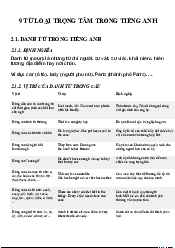


Preview text:
lOMoARcPSD| 39099223
Language for the introduction of an oral presentation Introduce the topic •
This presentation will investigate/ examine/ identify/ the effects of … • My topic today is … •
The topic I intend to discuss is … •
Our team/group will be discussing …
Provide an outline of the presentation •
I want to start by …, and then I’ll … •
Let’s begin by … , before looking at … •
I’m going to divide this talk into three parts. •
There a four main points I’d like to discuss: X, Y, Z and A. •
The effects of … will be shown by a comparison of x and y.
Language for the body of an oral presentation Introduce a main point • A major concern is … • The crux of the matter … • Fundamentally … •
The central problem is that … • A basic point was … •
A significant issue has been … Move to another main point • Now let’s consider … •
I’d like to move on to/look at … • If I could now turn to … • My next point is … • Now, turning to … • Now what about … • Let me move on to … Introduce an example • Let me illustrate this by … • A case in point is … • Take the case of … • This is illustrated by… lOMoARcPSD| 39099223 • This is demonstrated by … •
I refer you to the X, which illustrates … • An example of this is … Rephrase a main point • That is to say … • So now what we have is … • The point I am making is … •
Let me put that another way … • In other words … • As I have been saying … Introduce a digression • I might just mention … • Incidentally … • That reminds me …
Include summaries before moving on to another point •
So, that’s the general picture for X, now let’s look at Y •
That completes my overview of X, so now I’d like to move on to Y…
If your presentation has some visual materials such as diagrams, tables and other
illustrations, it is best to prepare the audience for what they are going to see. Don’t
just show a visual aid; make sure that the audience is alert and ready for the visuals
and stimulate their interest by using some signaling and transition words.
Draw the audience’s attention to the visual •
Now, let’s look at the position for … • Now, I’ll show you … • As you can see here … • I’d like to point out … • The diagram indicates … •
Let’s move on and look at the graph of … • The next slide indicates …
Explain what the visual is indicating •
This chart compares the production in two countries … •
The upper part of the slide illustrates … •
You can see here the development over the past ten years …
Language for the conclusion of an oral presentation lOMoARcPSD| 39099223 • To sum up … • Therefore … • In conclusion … • As a result, … • To recapitulate … • To conclude … • In summary … • Thus, we can see … • To summarise … • Finally, I want to say …
Language for inviting questions •
Are there any questions you’d like to ask? •
Does anyone have any questions? •
I’m happy to take any questions. •
Would anyone like me to explain anything further Any questions? •
If you have any questions, please ask.
https://emedia.rmit.edu.au/learninglab/content/signal-and-transition-words




